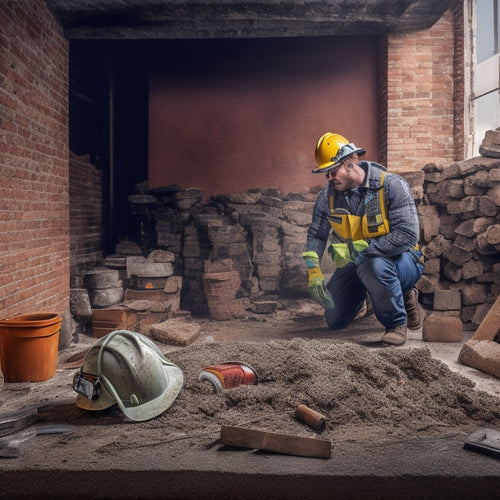
Top Concrete Removal Tools for Home Renovation
Share
When tackling a home renovation that involves concrete removal, you'll need an arsenal of specialized tools to get the job done efficiently and safely. High-powered jackhammers, pry bars, and concrete crushers are essentials, while power tools like rotary hammers, demolition saws, and reciprocating saws can enhance your removal process. Heavy-duty breaker hammers are designed for thick, reinforced concrete structures, and concrete saws provide precise cutting. Don't forget specialized drill bits and pneumatic chiseling tools for specific tasks. By understanding the capabilities and safety considerations of each tool, you'll be well-equipped to tackle your concrete removal project - and there's more to discover about maximizing their effectiveness.
Key Takeaways
• For efficient concrete removal, prioritize high-powered jackhammers, pry bars, and concrete crushers, with a focus on demolition safety.
• Power tools like rotary hammers, demolition saws, and reciprocating saws enhance concrete removal, with selection based on power output, speed, and weight.
• Heavy-duty breaker hammers are ideal for thick, reinforced concrete structures, with proper breakdown techniques and safety measures.
• Concrete saws provide precise cutting, with evaluation of cutting techniques and high-quality saw blades essential for effective removal.
• Specialized drill bits, including diamond core bits and masonry bits, are necessary for efficient concrete penetration and varied removal tasks.
Top Rated Demolition Tools
When tackling concrete removal, you'll need a reliable arsenal of top-rated demolition tools, including high-powered jackhammers, pry bars, and concrete crushers, to efficiently break up and remove unwanted concrete structures.
These tools are designed to withstand the rigors of demolition, but it's vital to prioritize demolition safety to avoid accidents and injuries. Always wear protective gear, such as gloves, goggles, and a dust mask, and guarantee a safe working distance from the demolition area.
Regular tool maintenance is also important to prolong the lifespan of your equipment and prevent breakdowns. Check your tools regularly for signs of wear and tear, and perform routine maintenance tasks, such as lubricating moving parts and replacing worn-out components.
Additionally, follow the manufacturer's guidelines for tool usage and maintenance to guarantee peak performance. By prioritizing demolition safety and tool maintenance, you can complete your concrete removal project efficiently and effectively, while minimizing the risk of accidents and equipment failures.
Power Tools for Concrete Demolition
To further enhance your concrete removal capabilities, you'll want to incorporate power tools specifically designed for concrete demolition into your arsenal, including rotary hammers, demolition saws, and reciprocating saws.
These power tools are designed to tackle heavy-duty concrete removal tasks, making them essential for efficient and effective concrete removal techniques.
When selecting power tools for concrete demolition, consider factors such as power output, speed, and weight. Rotary hammers, for instance, are ideal for breaking up thick concrete slabs, while demolition saws are better suited for cutting through concrete pipes or walls.
Reciprocating saws, on the other hand, are versatile and can be used for both breaking and cutting concrete.
Remember to always follow safety precautions when working with power tools for concrete demolition. Wear protective gear, including gloves, safety glasses, and a dust mask, to prevent injury from flying debris and dust.
Additionally, verify you're working in a well-ventilated area to avoid inhaling dust and fumes.
Heavy-Duty Breaker Hammers
With their robust design and powerful hitting force, heavy-duty breaker hammers are the go-to tool for demolishing thick, reinforced concrete structures, allowing you to tackle even the most challenging projects with ease. These hammers typically feature a high-torque motor, which generates a tremendous amount of force to break through concrete.
When using a heavy-duty breaker hammer, it's crucial to employ proper breakdown techniques to avoid damaging the surrounding area or the tool itself. This includes starting with a series of small, controlled blows to create a crack, then gradually increasing the force to widen the crack and eventually break the concrete into manageable pieces.
Don't forget to take necessary safety precautions when operating a heavy-duty breaker hammer. Wear protective gear, such as goggles, gloves, and a dust mask, to prevent injury from flying debris and dust. Verify a stable footing and maintain a firm grip on the hammer to prevent loss of control.
Additionally, always follow the manufacturer's instructions and guidelines for the specific tool you're using. By combining the right techniques with the appropriate safety measures, you'll be able to efficiently demolish concrete structures and achieve professional-grade results.
Efficient Concrete Saw Options
You'll find that concrete saws offer a more precise and controlled approach to concrete removal, allowing you to make clean cuts and avoid damaging surrounding structures. When it comes to efficient concrete saw options, you'll want to evaluate the following factors to guarantee you're getting the job done effectively.
Concrete cutting techniques: Look for saws that can perform various cutting techniques, such as plunge cutting, ripping, and cross-cutting, to tackle different concrete removal tasks.
Saw blade types: Choose saws with high-quality blades designed specifically for concrete cutting, such as diamond blades or abrasive blades, which provide maximum performance and longevity.
Power source: Decide between electric, gas, or hydraulic-powered saws based on your specific needs and the size of your project.
Blade diameter and arbor size: Select saws with blades that match the size of your project, and verify the arbor size is compatible with your saw's shaft.
Safety features: Opt for saws with built-in safety features, such as blade guards and dust collection systems, to minimize risks and maintain a safe working environment.
Specialized Drill Bits for Concrete
Six specialized drill bits are essential for efficiently penetrating concrete, each designed to tackle specific tasks and provide ideal results. You'll need a combination of these bits to cover various concrete removal tasks.
For example, diamond core bits are perfect for drilling precise holes for anchors, pipes, or conduits in concrete walls or floors. These bits feature a diamond-coated edge that effectively cuts through concrete, making them ideal for creating clean, round holes.
Masonry bits, on the other hand, are designed for drilling into brick, block, or concrete. They have a tungsten-carbide tip that's extremely hard and durable, allowing you to drill through tough materials with ease.
You'll also need bits with a hammer drill function to effectively penetrate concrete. Additionally, consider using step bits that allow you to drill holes of varying sizes with a single bit, saving you time and effort.
Other essential drill bits include spiral bits for drilling large holes, hole saws for making precise cuts, and countersink bits for creating countersinks in concrete.
With these specialized drill bits, you'll be well-equipped to tackle any concrete removal task that comes your way.
Pneumatic Chiseling Tools for Walls
When tackling concrete removal tasks on walls, pneumatic chiseling tools prove indispensable for efficiently breaking up and removing concrete, allowing you to make swift progress on your renovation project. These powerful tools utilize compressed air to deliver a high-impact force, making quick work of even the toughest concrete structures.
To get the most out of your pneumatic chiseling tools, keep the following tips in mind:
-
Regularly inspect and maintain your pneumatic chisel to prevent damage and guarantee peak performance, including checking for worn or damaged seals and cleaning the tool after each use.
-
Always wear appropriate personal protective equipment (PPE) when operating pneumatic tools, including safety glasses, ear protection, and a dust mask.
-
Ensure a stable and secure footing when operating the tool to prevent accidents and maintain control.
-
Use the correct chisel bit for the specific concrete removal task at hand, as different bits are designed for varying levels of concrete hardness and removal requirements.
-
Familiarize yourself with pneumatic tool safety guidelines and best practices to minimize the risk of injury or damage.
Frequently Asked Questions
Can I Reuse Removed Concrete for Future Projects or Landscaping?
When you remove concrete, you're left wondering if you can reuse it for future projects or landscaping. The good news is, you can!
Recycling removed concrete offers several benefits, including reduced waste and lower costs.
You can crush the concrete into aggregate for new construction or use it as a base material for landscaping ideas like pathways, patios, or even decorative features like retaining walls or planters.
How Do I Protect Surrounding Surfaces From Damage During Demolition?
'Oh, you thought smashing things was the hard part? Think again!
Protecting surrounding surfaces from damage during demolition is where the real challenge begins. You'll need to suit up your surfaces with proper protection, like plastic sheets or plywood, to prevent scratches and cracks.
Employ demolition techniques like controlled demolition or hand demolition to minimize the risk of damage.
What Safety Gear Is Essential for Concrete Removal Projects?
When tackling concrete removal projects, you'll need essential safety gear to protect yourself from hazards.
You'll require safety goggles with impact-resistant lenses to shield your eyes from flying debris and dust.
Additionally, invest in noise protection like earplugs or earmuffs to safeguard your hearing from the loud machinery and drilling.
Can I Remove Concrete Without Professional Help or Training?
You're wondering if you can tackle concrete removal on your own without professional help or training. While it's possible, it's essential to acknowledge the risks involved.
DIY techniques, such as breaking and prying, can be effective, but they require careful planning and execution.
Familiarize yourself with various concrete removal methods, including chemical demolition and manual demolition, to determine the best approach for your project.
How Do I Dispose of Removed Concrete and Debris Responsibly?
You've conquered the concrete removal beast, but now you're left with a challenging task: responsible disposal. Don't let the excitement of your renovation project fade - you must tackle this vital step.
You'll need to explore concrete disposal methods that don't harm the environment. Consider recycling concrete debris, a sustainable approach that reduces waste and conserves natural resources.
Research local facilities that accept construction materials and follow their guidelines to guarantee a guilt-free renovation.
Conclusion
As you wrap up your concrete removal task, you've got the right tools to thank for a job well done.
From breaker hammers to concrete saws, each one played an essential role in tearing down the old to make way for the new.
But the question remains: what's the most critical tool in your arsenal - the one that made the biggest impact on your renovation's success?
Related Posts
-

7 Must-Have Safety Gears for Brick Wall Renovation
When renovating a brick wall, you'll face a multitude of hazards, making it essential to wear and use the right safet...
-

Why Exterior Wall Renovation Requires a Plan
You're about to commence a complex and potentially costly project when you decide to renovate your exterior walls, an...
-

Why Use a Home Renovation Budget Template
By using a home renovation budget template, you'll greatly reduce project stress and anxiety by streamlining financia...


